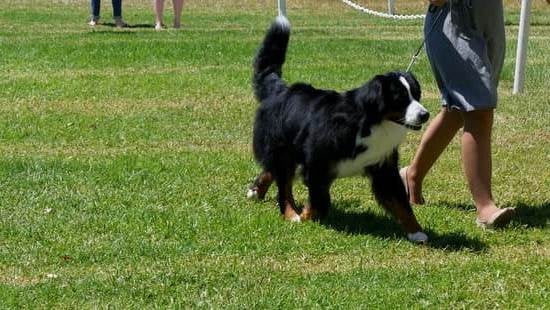Can you leash train an older dog? This is a question that many pet owners may have, as there is a common misconception that training an older dog, especially when it comes to leash training, can be challenging or even impossible.
However, with the right approach and techniques, it is definitely possible to teach an older dog to walk politely on a leash. In this article, we will explore the benefits of leash training for older dogs, how to assess your dog’s readiness for training, choosing the right equipment, and tips for successful leash training.
Leash training older dogs can offer numerous benefits for both you and your furry companion. Not only does it improve their behavior and make walks more enjoyable, but it also enhances safety for both of you.
A well-behaved dog on a leash reduces the risk of accidents or confrontations with other animals or people. By investing time and effort into leash training your older dog, you can strengthen your bond and create a positive experience for both of you during daily walks.
Before diving into the actual training process, it is important to assess your older dog’s temperament and readiness for leash training. Understanding their behavior patterns and any potential challenges they may face will help tailor your approach accordingly.
Additionally, choosing the right leash and collar that prioritize comfort and safety is crucial in setting up your older dog for success in their training journey. With patience, consistency, and positive reinforcement techniques, you can effectively teach your older furry friend how to walk politely on a leash.
Benefits of Leash Training for Older Dogs
Leash training is often associated with puppies or younger dogs, but the truth is that older dogs can also benefit greatly from leash training. Not only does it provide a sense of structure and boundaries for your furry companion, but it also enhances safety for both you and your dog during walks or outings. While some may believe that older dogs cannot be trained, it is never too late to start leash training and improve their behavior.
Improved Behavior
One of the key benefits of leash training for older dogs is the improvement in behavior that comes with structured walks. By teaching your older dog to walk politely on a leash, you can address any issues such as pulling, lunging, or excessive barking.
Leash training provides mental stimulation and physical exercise, which can help reduce anxiety, aggression, and other behavioral problems that may arise in older dogs. Additionally, a well-behaved dog on a leash can prevent accidents or confrontations while out in public spaces.
Enhanced Safety
Another important aspect of leash training for older dogs is the increased safety it offers. Older dogs
By teaching them to walk calmly on a leash, you can ensure that they stay close to you and avoid potential dangers like traffic or aggressive animals. Leash training also
Mental Stimulation
In addition to improved behavior and safety, leash training provides valuable mental stimulation for older dogs. Learning new behaviors and commands through positive reinforcement techniques
Assessing Your Older Dog’s Temperament and Readiness for Leash Training
Understanding Your Older Dog’s Behavior
Before embarking on leash training for your older dog, it is crucial to take the time to understand their behavior and temperament. Older dogs may have different needs and responses compared to younger dogs, so it is essential to tailor your training approach accordingly.
Some older dogs may have physical limitations or health issues that can affect their ability to walk on a leash comfortably. By observing your dog’s behavior in various situations, you can gain insight into how they might react to leash training.
Evaluating Your Dog’s Comfort Level With Equipment
Another important aspect of assessing your older dog’s readiness for leash training is to evaluate how they respond to the equipment. Ensure that the collar or harness you choose is comfortable and secure for your furry companion.
Introduce the leash gradually, allowing your dog to sniff and get accustomed to it before starting any training sessions. If your older dog shows signs of discomfort or reluctance, consider trying different types of collars or harnesses until you find one that they are comfortable with.
Setting Realistic Expectations for Training
It is essential to set realistic expectations when assessing your older dog’s readiness for leash training. Understand that older dogs may not learn as quickly as younger puppies and may require more time and patience during the training process.
Be prepared for setbacks and progress at a pace that is comfortable for your furry friend. By approaching leash training with understanding and empathy towards your older dog’s needs, you can successfully leash train an older dog while strengthening the bond between you both.
Choosing the Right Leash and Collar for Your Older Dog
When it comes to leash training an older dog, one of the key considerations is choosing the right leash and collar for your furry friend. It is essential to prioritize both comfort and safety when selecting these items to ensure a positive training experience for your older dog.
When it comes to leashes, you may want to consider a longer leash for an older dog who may require more freedom to move around comfortably during walks. Additionally, a hands-free leash can be a great option for pet owners with mobility issues or those looking for a more convenient walking experience. For collars, opt for one that fits properly and does not cause discomfort or irritation to your older dog’s neck.
For older dogs with specific health concerns or mobility issues, there are specialized harnesses and collars available that provide extra support and protection during walks. These options can help alleviate any pain or discomfort your older dog may experience while wearing a traditional collar and leash.
Remember, the goal is to make leash training as enjoyable and stress-free as possible for both you and your older dog. By selecting the right leash and collar that prioritize comfort and safety, you can set the stage for successful leash training sessions that will benefit your furry companion in the long run.
How to Start Leash Training an Older Dog
Leash training an older dog may seem like a daunting task, but it is definitely possible with the right approach. Many pet owners wonder, “Can you leash train an older dog?” The answer is yes. While older dogs may have established habits and behaviors, they are still capable of learning new skills with patience and consistency.
To start leash training an older dog, it is important to set realistic expectations and be prepared to invest the time needed for the training process. Begin by introducing your older dog to the leash and collar in a calm and positive manner. Allow them to sniff and explore the new equipment before gently attaching it.
Patience is key when starting leash training with an older dog. Start slowly by taking short walks in familiar environments to help your furry friend get used to walking on a leash. Use treats and praise to reinforce desired behaviors, such as walking beside you without pulling.
Consistency is also crucial – make sure to practice regularly and reinforce good behavior consistently. Remember, every dog learns at their own pace, so be patient and understanding throughout the training process. With dedication and positive reinforcement techniques, you can help your older dog become comfortable and confident on a leash.
Dealing With Common Challenges During Leash Training
Distractions are another challenge that pet owners may encounter during leash training sessions with their older dogs. Older dogs may have developed strong habits or reactions to certain stimuli in their environment, leading to difficulties in maintaining focus during walks.
When faced with distractions such as other animals, loud noises, or unfamiliar sights, it’s important to redirect your dog’s attention back to you by using treats or toys as incentives. Consistent training in different environments can also help desensitize your older dog to distractions over time.
Fear can also play a significant role in hindering an older dog’s progress during leash training. Whether it stems from past negative experiences or unfamiliar situations, fear can cause older dogs to exhibit anxious behaviors or reluctance to walk on a leash. To address fear-related challenges, it’s essential to create a safe and positive environment for your dog during training sessions.
Gradual exposure to new stimuli paired with rewards for calm behavior can help build confidence and trust between you and your furry friend. With patience and understanding, even older dogs can overcome their fears and learn to enjoy their daily walks on a leash.
| Challenges | Training Strategies |
|---|---|
| Pulling | Practice patience; Use positive reinforcement; Gentle corrections |
| Distractions | Redirect attention with treats/toys; Practice consistency in different environments |
| Fear | Create a safe environment; Gradual exposure paired with rewards; Build confidence through trust |
Progress Tracking and Adjusting Your Training Approach as Needed
Leash training an older dog is definitely possible, and progress tracking plays a crucial role in the success of this endeavor. By monitoring your dog’s development throughout the training process, you can adapt your approach as needed to ensure that they are learning effectively. Here are some tips for progress tracking and adjusting your training approach for your senior canine companion:
- Documenting behavior: Keep a journal or log of your older dog’s behavior during leash training sessions. Note any improvements, setbacks, or patterns that may arise. This will help you have a clear understanding of how your dog is responding to the training.
- Setting goals: Establish realistic goals for your older dog’s leash training progress. Whether it’s walking calmly on the leash for a certain distance or reducing pulling behaviors, having clear objectives can help guide your training sessions.
- Monitoring feedback: Pay attention to cues from your older dog during leash training. Are they showing signs of stress or discomfort? Are they responsive to your commands and cues? Adjusting your approach based on their feedback can make a significant difference in their learning process.
Remember that every older dog is unique, so what works for one may not necessarily work for another. Being flexible in your training methods and open to making adjustments along the way can lead to a more successful outcome. Patience and understanding are key when it comes to progress tracking and adapting your training techniques for leash training an older dog. With dedication and consistency, you’ll be able to see positive results in no time.
- Seeking professional guidance: If you find yourself facing challenges or struggling with progress tracking during leash training, don’t hesitate to seek guidance from a professional dog trainer or behaviorist. They can provide valuable insights and support tailored to your older dog’s specific needs.
- Celebrating small victories: In the journey of leash training an older dog, it’s important to celebrate even the smallest achievements along the way. Whether it’s walking without pulling for a few steps or staying focused despite distractions, acknowledging these wins can boost motivation for both you and your furry friend.
- Adjusting expectations: Understand that leash training an older dog takes time and patience. Some dogs may progress quickly, while others may require more time to learn new behaviors. Adjusting your expectations and being realistic about timelines can help alleviate frustration and maintain a positive attitude throughout the process.
The Importance of Continued Practice and Reinforcement for Long-Term Success
Many pet owners may wonder, “Can you leash train an older dog?” The answer is a resounding yes. While it may take more time and patience compared to training a younger dog, older dogs are certainly capable of learning leash manners and behavior. In fact, leash training can be especially beneficial for older dogs as it provides them with mental stimulation, physical exercise, and an opportunity to strengthen their bond with their human companion.
Leash training an older dog comes with a host of benefits. Not only does it enhance the safety of your walks by preventing your senior pup from wandering off or getting into potentially dangerous situations, but it also improves their overall behavior.
For older dogs who may have developed bad habits over the years, consistent leash training can help correct these behaviors and instill a sense of discipline and control. Additionally, regular walks on a leash can help maintain your dog’s physical health and keep them mentally sharp.
Before embarking on the leash training journey with your older dog, it’s essential to assess their temperament and readiness for such training. Some senior dogs may have physical limitations or medical conditions that affect their ability to walk on a leash comfortably. Consulting with your veterinarian to ensure that your furry companion is in good health for leash training is crucial.
Once you have the green light from your vet, consider your dog’s personality traits – are they easily spooked by unfamiliar sights and sounds? Do they have a tendency to pull on the leash? Understanding these factors will help tailor your training approach to suit your older dog’s needs.
| Benefit | Description |
|---|---|
| Improved Behavior | Leash training can help correct bad habits in older dogs |
| Safety | Prevents wandering off and keeps older dogs out of harm’s way during walks |
| Bond Strengthening | Leash training provides mental stimulation and strengthens the bond between dogs and their owners |
Success Stories of Older Dogs Who Have Successfully Been Leash Trained
Leash training an older dog may seem like a daunting task, but many pet owners have found great success with patience, consistency, and positive reinforcement techniques. While some may believe that older dogs cannot learn new tricks, the truth is that with the right approach and dedication, leash training can be achieved at any age. Here are a few heartwarming success stories of older dogs who have successfully been leash trained:
- Max, a 10-year-old rescue dog, was initially hesitant to walk on a leash due to past trauma. Through gradual exposure and positive reinforcement, his owner was able to build his confidence and now Max enjoys daily walks around the neighborhood without any issues.
- Sadie, a 9-year-old Labrador Retriever, used to constantly pull on the leash during walks, making it a stressful experience for her owner. With the help of a no-pull harness and consistent training sessions, Sadie has learned to walk politely by her owner’s side.
- Bella, an 11-year-old Dachshund mix, struggled with fear-based reactivity towards other dogs while on a leash. Her owner worked with a professional trainer to desensitize Bella to triggers and replace her fear with positive associations. Today, Bella can go on walks peacefully without any signs of aggression.
Each of these success stories highlights the importance of patience, understanding your dog’s individual needs and limitations when it comes to leash training. With dedication and the right tools in place, any older dog can you leash train an older dog regardless of their age or previous experiences. So don’t be discouraged if your furry friend seems resistant at first – with time and effort, you too can achieve success in leash training your older dog.
Conclusion
Leash training an older dog may seem like a daunting task, but it is definitely possible with the right approach and commitment. As highlighted throughout this article, older dogs can indeed be leash trained, and the benefits of doing so are significant for both you and your furry companion. By investing the time and effort into leash training, you are not only improving their behavior and safety during walks but also strengthening the bond between you.
Assessing your older dog’s temperament and readiness for leash training is crucial in determining how to approach the process effectively. Choosing the right leash and collar that prioritizes comfort and safety ensures that your dog is not only secure but also comfortable during walks. Starting the training process with patience, consistency, and positive reinforcement techniques sets a solid foundation for success.
While challenges such as pulling, distractions, or fear may arise during leash training, it is important to address them calmly and consistently. Tracking progress and adjusting your training approach as needed will help tailor the experience to your dog’s specific needs. Ultimately, continued practice and reinforcement are key to long-term success in leash training older dogs.
So, if you find yourself asking, “Can you leash train an older dog?” remember that with dedication and the right tools, it is definitely achievable for a happier, healthier relationship with your faithful companion.
Frequently Asked Questions
Is It Too Late to Leash Train My Dog?
It is never too late to train a dog on a leash, although it may take more time and patience if they are older. Consistency and positive reinforcement are key to success.
What Is the Oldest Age a Dog Can Be Trained?
Dogs of any age can be trained, but the oldest age for effective training varies based on the individual dog’s health, cognitive abilities, and previous training experiences. Older dogs can still learn new tricks.
Can a Dog Be Too Old for Obedience Training?
A dog is never too old for obedience training. Training can help strengthen the bond between the dog and owner, improve behavior, mental stimulation, and overall quality of life, regardless of age. It’s never too late to start training.

Welcome to the blog! I am a professional dog trainer and have been working with dogs for many years. In this blog, I will be discussing various topics related to dog training, including tips, tricks, and advice. I hope you find this information helpful and informative. Thanks for reading!





